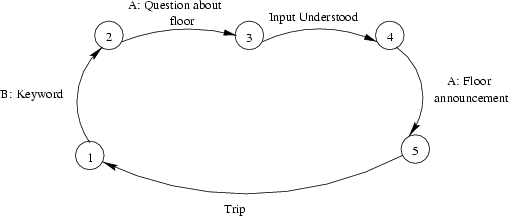4.2.2 A simple FSA example
The dialogue module of the speaking elevator is modeled by a finite state automaton.
The dialogue module of the speaking elevator is modeled by a finite state automaton. It handles input and output. For this purpose it communicates with a speech recogniser and a text to speech synthesiser. Specific kinds of spoken input are expected according to the current state. Besides that, it also communicates with the hardware and controls mechanical actions.
As a first example let us look at a FSA dialogue manager that could be used to produce very simple elevator dialogues. As we will soon see, the real speaking elevator's FSA is somewhat more complex. Still it is based on the same structure. The dialogue module of the speaking elevator handles input and output and it controls mechanical actions. It communicates with a speech recogniser and a text to speech synthesiser. Specific kinds of spoken input are expected according to the current state. It also communicates with the hardware. So a very simple FSA for elevator dialogues consists of five states and five arcs and looks as follows:
A simple finite state automaton

State 1 is the initiating state. In the elevator it is expecting a particular keyword. When the keyword is recognised, the system is set to State 2. A question about which floor the user wants to go to is produced, which sets the system to state 3. The user's input is recognised, which sets the system to state 4. The system informs the user of the floor he is being taken to and the state after that is State 5. After State 5, the trip begins and the system is reset.
From this picture we can see another difference between finite state systems used in dialogue processing and FSAs in the strict sense as we have seen them in previous lectures: Dialogue automata don't always have final states. This is of course because dialogues systems - like for instance in an elevator - often need to be ready for new input immediately when one dialogue is over, and shouldn't be ``switched off'' after one interactive sequence. This can be symbolised by simply looping back to the intial state. In the above picture, we could just as well regard state 5 as final state and view the trip-and-reset as external to the automaton.
Example dialogue
Our simple automaton is able to generate only dialogues of the following kind.
User: | Elevator. |
System: | Which floor do you want? |
User: | Professor Bill Barry. |
System: | I'm taking you to the Fifth floor. |
(Mechanical command execution follows) |
One thing that this dialogue does not allow the user is to confirm or correct the system in case of a misrecognition. We will now look at various ways of mending this shortcoming.